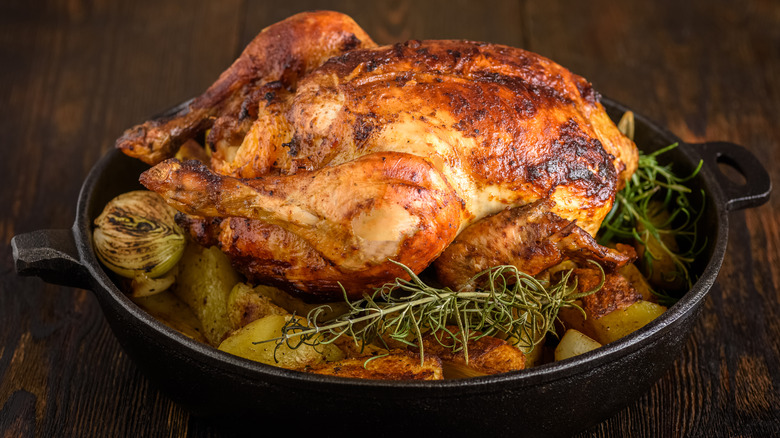The Science Behind Why Roasted Foods Stay So Moist
There's a reason you were always told to baste your Thanksgiving turkey several times or to apply mayonnaise under the skin of a roasting chicken. With so many different ways to cook meat, it's not only the cooking style that matters but the technique that goes into it.
Roasting typically occurs in an oven, where food is cooked at high temperatures. As KitchenAid explains, this allows the meat to cook while also forming a caramelized skin, which adds to the food's flavor profile. When roasting food, make sure to position it on the center oven rack. This way, heat can surround the food evenly. And while the same method is used for roasting vegetables, KitchenAid suggests that one difference with meat is to place it on a rack and out of its drippings, which allows all four sides of the meat to caramelize.
The reason so many people choose to roast their meat is because it locks in moisture. And while the skin helps with that, there's science behind why you use a technique such as basting the meat while it cooks.
Here's why roasted foods stay moist
When it comes to locking in moisture, it's all about the fat. When you add an element of fat, the meat doesn't dry up as quickly.
For example, cooking a chicken with the skin on helps lock in moisture because chicken skin has plenty of fat. According to Cook's Illustrated, for added fat elements, you can baste the meat, letting the oils and melted fat pour over it. Another option is to coat the meat in fat, such as mayonnaise, per Eatwell101.
The Accidental Scientist explores the science behind the process of fatty meats having more flavor, too. Cuts of meat with the most fat stay moist because the fat melts when it's heated. A fatty piece of meat whose fat fibers melt within the meat will help to moisten the rest of the meat while it cooks, creating a juicy, tender flavor.
How to roast meat properly
There's a lot more to this cooking technique than just remembering to baste the meat every now and then. It's a whole process, and it starts with properly preheating your oven. Food Network suggests doing so for at least 20 minutes, even if it doesn't take that long for your oven to reach the desired temperature.
Plus, make sure your meat isn't refrigerator temperature when you start to cook it. Allow it to sit out on the counter for up to two hours (but not more than two for risk of food poisoning) and get as close to room temperature as possible.
If you know you plan to roast the meat, it wouldn't hurt to ask the butcher to tie it. The process, called trussing, helps the meat retain its shape and keeps the juices inside, according to Food Republic. From there, Food Network says to season it well with salt and pepper, top it with a fat element (such as butter or mayonnaise), and roast it in the oven, in a roasting pan with a rack — the cook time depends on the meat and recipe. Once it's done, let it rest up to 15 minutes before slicing it.


